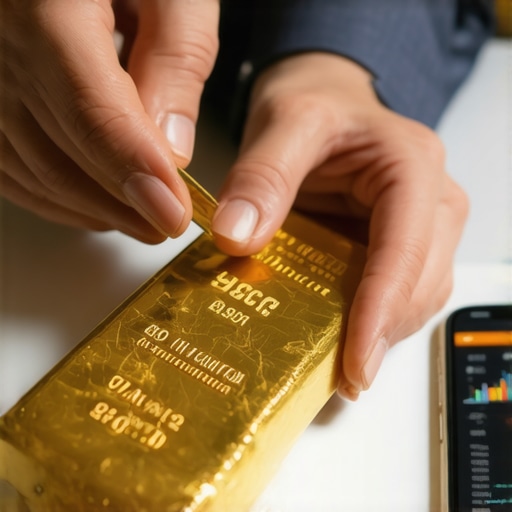Understanding the Gold Investment Landscape
As new investors venture into the world of gold, it’s essential to grasp the dynamics of this precious metal. Gold has historically been a safe haven during economic uncertainties and inflationary periods. With global markets fluctuating, understanding how to invest in gold can provide security and potential growth for your portfolio.
Why Invest in Gold?
One of the primary reasons to consider investing in gold is its ability to act as a hedge against inflation. When fiat currencies lose value, gold tends to retain its purchasing power. Additionally, gold is a tangible asset, unlike stocks or bonds, offering a sense of stability. In times of geopolitical tensions or economic downturns, gold prices often surge, making it a strategic choice for investors looking to diversify their portfolios.
Essential Tips for New Gold Investors
For those new to gold investing, here are some essential tips to consider:
1. Research Different Types of Gold Investments
Gold can be purchased in various forms, including physical gold bars, coins, and gold-backed ETFs. Each type has its advantages and disadvantages. For instance, investing in physical gold bars may provide a tangible asset but comes with storage and insurance costs. On the other hand, gold ETFs are more liquid and don’t require physical storage.
2. Stay Informed About Market Trends
Gold prices are influenced by various factors, including supply and demand, geopolitical events, and central bank policies. Staying updated with market trends will help you make informed decisions and time your investments effectively.
3. Know Your Investment Goals
Before diving into gold investment, it’s crucial to define your goals. Are you looking for short-term gains or long-term security? Your investment strategy should align with your financial objectives. Explore gold investment strategies that resonate with your financial plans.
4. Diversify Your Portfolio
While gold can be a fantastic investment, it’s essential to maintain a diversified portfolio. Overexposure to any asset class can lead to increased risk. Consider combining gold investments with other asset types like stocks, bonds, or real estate to mitigate risks.
5. Consult with Experts
Engaging with financial advisors or gold investment experts can provide valuable insights tailored to your specific situation. They can help you navigate the complexities of the gold market and develop a strategy that aligns with your investment goals.
Conclusion
Investing in gold can be a rewarding endeavor if approached with careful consideration and strategy. By understanding the market, researching various investment options, and defining your goals, you can effectively navigate today’s gold investment landscape. For further reading, check out our guide on the benefits of adding gold to your investment portfolio.
Understanding Different Gold Investment Vehicles
As you delve deeper into the world of gold investment, it’s vital to familiarize yourself with the different vehicles available. Each type of investment offers unique benefits and considerations that can significantly impact your overall strategy.
1. Physical Gold: Bars and Coins
Investing in physical gold, such as bars or coins, remains a popular choice for many investors. This tangible asset provides a sense of security and ownership. However, it’s crucial to consider factors such as storage costs and insurance when opting for physical gold. Understanding the market value of gold coins can also help you make informed decisions.
2. Gold ETFs: A Modern Approach
Gold Exchange-Traded Funds (ETFs) offer a modern way to invest in gold without the hassles of physical storage. These funds track the price of gold and can be easily bought or sold on the stock market, making them a liquid and flexible option. For a comprehensive understanding of this investment type, refer to our guide on investing in gold ETFs.
Evaluating Gold Market Trends
Staying informed about the latest trends in the gold market is essential for any investor. The price of gold is influenced by various factors, including global economic conditions, inflation rates, and geopolitical tensions. Understanding these dynamics can provide insights into when to buy or sell your gold assets.
1. Global Economic Indicators
Pay attention to global economic indicators such as interest rates and inflation, as they play a significant role in gold pricing. A rising inflation rate often leads to higher gold prices, as investors seek to hedge against currency devaluation.
2. Geopolitical Events and Their Impact
Geopolitical tensions can create uncertainty in the markets, often driving investors towards gold as a safe haven. Keeping abreast of current events can help you anticipate market shifts and adjust your investment strategy accordingly. For more insights on how external factors affect gold prices, explore our post on gold price dynamics.
Building a Resilient Gold Investment Portfolio
A well-rounded gold investment portfolio is crucial for mitigating risks and maximizing returns. Here are some strategies to consider:
1. Diversification within Gold Investments
While gold is a strong asset class, diversifying within your gold investments can further reduce risk. Consider a mix of physical gold, ETFs, and even gold mining stocks to create a robust portfolio. Insights into gold mining stocks can enhance your investment strategy.
2. Setting Clear Investment Goals
Clearly defining your investment goals will help you determine your approach to gold investing. Are you aiming for long-term appreciation, or are you looking for short-term gains? Aligning your strategy with your financial objectives is critical for success.
Conclusion
Investing in gold requires careful planning and informed decision-making. By understanding the various investment vehicles, staying updated on market trends, and building a diversified portfolio, you can navigate the complexities of the gold market effectively. For further information, consider reading our comprehensive guide on future gold investment trends.
Analyzing Gold Price Trends for Better Investment Decisions
Understanding how to analyze gold price trends is crucial for making informed investment decisions. By studying historical price movements, you can identify patterns that may signal future price changes. For example, looking at long-term charts can help you recognize cycles in gold prices that align with broader economic trends.
1. Historical Price Analysis
Reviewing historical gold prices not only provides context but also helps in forecasting future movements. Investors should pay attention to significant historical events that have impacted gold prices, such as economic crises or geopolitical conflicts. This analysis can guide you on when to enter or exit the market.
2. Technical Indicators to Watch
Utilizing technical indicators, such as moving averages or Relative Strength Index (RSI), can enhance your trading strategy. These tools help you assess market momentum and identify potential reversal points. For instance, a crossover of short-term and long-term moving averages may indicate a trend shift worth considering.
Understanding the Role of Central Banks in Gold Pricing
The actions of central banks significantly influence gold prices. By understanding their strategies, investors can anticipate market movements more effectively. Central banks often hold substantial gold reserves and adjust their holdings based on economic conditions, which can lead to fluctuations in gold prices.
1. Central Bank Purchases and Gold Demand
When central banks increase their gold reserves, it typically signals a bullish outlook on gold, leading to potential price increases. Monitoring these purchases can provide insights into market sentiment. For more detailed analysis, check out our post on how central bank purchases affect gold prices.
2. Monetary Policy Impacts
Changes in monetary policy, such as interest rate adjustments, directly impact gold prices. Lower interest rates often result in higher gold prices since the opportunity cost of holding non-yielding assets like gold diminishes. Investors should stay informed about central bank announcements to gauge possible price movements.
Effective Gold Trading Techniques for Maximizing Returns
To achieve the best results from gold investments, employing effective trading techniques is essential. These methods can help you capitalize on price movements and enhance your overall investment strategy.
1. Timing Your Trades
Timing is everything in trading. Understanding the best times to buy or sell gold can have a significant impact on your returns. Utilize market analysis and stay informed on global economic news to make well-timed decisions.
2. Leveraging Gold Trading Strategies
Consider leveraging various trading strategies, such as day trading or swing trading, to take advantage of short-term price fluctuations. Each strategy has its own risk profile, so it’s important to choose one that aligns with your investment goals. For more insights, explore our guide on top gold trading techniques for successful investments.
Conclusion
In conclusion, navigating the gold investment landscape requires a strategic approach that combines market analysis, an understanding of central bank influences, and effective trading techniques. By implementing these strategies, investors can optimize their returns and make informed decisions in the dynamic world of gold investing. For further insights on gold investments, consider reading our article on the future of gold price predictions.
Exploring Gold Investment Vehicles: A Closer Look
When it comes to investing in gold, understanding the various investment vehicles available is essential for building a diversified portfolio. Each option comes with its own set of benefits and risks, making it crucial to choose wisely based on your financial goals and market conditions.
1. Physical Gold Investments: Bars and Coins
Investing in physical gold, such as bullion bars and coins, remains a popular choice among investors. This tangible asset allows you to hold your investment directly, offering a sense of security. However, it also requires considerations such as storage and insurance. For more insights on purchasing physical gold, check out our article on the benefits of purchasing physical gold investments.
2. Gold ETFs and Mutual Funds
Gold Exchange-Traded Funds (ETFs) and mutual funds provide a more liquid way to invest in gold without the hassles of physical storage. These investment vehicles track the price of gold and can be bought and sold on stock exchanges, making them accessible and easy to manage. When considering these options, it’s vital to research the fees and performance history of each fund to ensure optimal returns.
Understanding Gold Futures: A Strategic Approach
Gold futures contracts allow investors to speculate on the future price of gold. This advanced trading strategy provides the opportunity for significant profits but carries high risks. Understanding how gold futures work is essential before diving into this market.
1. Leveraging Gold Futures for Profit
Using leverage in gold futures enables traders to control a larger position with a smaller amount of capital. While this can amplify potential gains, it also increases the risk of substantial losses. Investors should carefully assess their risk tolerance and market conditions before utilizing this strategy. For those looking to explore this further, our guide on understanding gold futures: a beginner’s perspective offers valuable insights.
2. Hedging Against Market Volatility
Gold futures can also serve as a hedge against market volatility. By taking a position in gold futures, investors can protect their portfolios from adverse movements in other asset classes. This strategic approach can help maintain overall portfolio stability during turbulent economic periods.
Evaluating Gold Mining Stocks: An Investment Alternative
Investing in gold mining stocks presents another avenue to gain exposure to the gold market. These stocks can offer leverage to gold prices, as mining companies typically experience higher profit margins when gold prices rise. However, it’s crucial to analyze individual companies based on their operational efficiency, production levels, and overall market conditions.
1. Assessing Company Fundamentals
When evaluating gold mining stocks, focus on key performance indicators such as production costs, reserves, and management effectiveness. Understanding a mining company’s fundamentals can help you identify promising investment opportunities. For deeper insights, read our article on exploring gold mining stocks: best options for 2025.
2. Market Sentiment and Gold Stock Performance
Market sentiment can significantly influence gold mining stocks. Factors such as geopolitical events, economic indicators, and changes in gold prices can impact stock performance. By staying informed about these dynamics, you can make more informed investment decisions.
Conclusion: Crafting Your Gold Investment Strategy
In conclusion, crafting a comprehensive gold investment strategy requires understanding the various investment vehicles and their associated risks and rewards. Whether you prefer physical gold, ETFs, or mining stocks, informed decision-making is key to optimizing your investment portfolio. To further enhance your knowledge, explore our post on how to analyze gold price trends like a pro.
Comprehensive FAQ Section: Your Gold Investment Questions Answered
1. What are the benefits of investing in gold?
Investing in gold offers several benefits, including its status as a hedge against inflation, currency fluctuations, and economic downturns. Gold can also provide portfolio diversification and is a tangible asset that retains intrinsic value.
2. How do gold ETFs work?
Gold ETFs (Exchange-Traded Funds) allow investors to buy shares that represent a specific amount of gold. These funds track the price of gold and are traded on stock exchanges, providing liquidity and ease of access to gold investments without the need for physical storage.
3. Are gold mining stocks a good investment?
Gold mining stocks can be a good investment, particularly when gold prices rise, as mining companies often see increased profits. However, they also carry risks related to operational challenges, management decisions, and market conditions, so thorough research is essential.
4. What is the difference between gold bullion and gold coins?
Gold bullion typically refers to gold bars or ingots that are valued based on their weight and purity. Gold coins, on the other hand, are minted and may carry numismatic value in addition to their gold content. Both can be good investments, depending on your strategy.
5. How can I safely store my physical gold investments?
Physical gold should be stored in a secure location, such as a safe deposit box at a bank, a home safe, or a professional vault service. It’s essential to ensure proper insurance coverage for your gold holdings to protect against theft or loss.
6. What factors influence gold prices?
Gold prices are influenced by various factors, including economic data, interest rates, inflation, geopolitical tensions, and changes in currency values. Understanding these dynamics can help investors make informed decisions regarding their gold investments.
7. Can I use gold to diversify my investment portfolio?
Yes, gold is an excellent asset for portfolio diversification. Its historical performance often moves independently of stock and bond markets, making it a valuable component to reduce overall portfolio risk.
8. What are the risks associated with gold investments?
While gold is often seen as a safe-haven asset, it is not without risks. These include price volatility, the potential for market manipulation, and the costs associated with storage and insurance for physical gold investments.
9. How can I start investing in gold?
To start investing in gold, determine your investment goals and risk tolerance. You can then choose from various options, such as purchasing physical gold, investing in gold ETFs, or exploring gold mining stocks, and make informed decisions based on thorough research.
10. Is gold a good long-term investment?
Gold has historically been considered a good long-term investment due to its ability to retain value over time. It can serve as a hedge against inflation and economic uncertainty, making it a reliable choice for wealth preservation.
Authority Resources for Gold Investment Insights
To further enhance your understanding of gold investment strategies and market dynamics, consider exploring the following trusted resources:
- Investopedia: Gold Investing Basics – A comprehensive guide that covers the fundamentals of gold investment.
- Kitco: Gold Market News and Analysis – A leading source for gold market news, prices, and expert analysis.
- World Gold Council – An authoritative source for gold-related data and research, including investment insights and trends.
- Bloomberg: Commodities Market – Up-to-date news and analysis on commodity markets, including gold.
- Morningstar: Gold ETFs Overview – Detailed information and performance data on various gold ETFs.
Conclusion: Your Path to Successful Gold Investment
In conclusion, investing in gold presents a myriad of opportunities and strategies that can enhance your financial portfolio. From physical gold to ETFs and mining stocks, understanding the various vehicles available is crucial for crafting a successful investment strategy. By leveraging the insights provided in this guide and utilizing authoritative resources, you can navigate the gold market with confidence and make informed decisions that align with your investment goals.











I find the point about gold serving as a hedge against inflation particularly compelling, especially given recent economic fluctuations. In my own investment journey, I’ve noticed that physical gold offers a comforting tangibility which stocks or digital assets simply can’t match. However, managing the storage and insurance costs of physical gold can be quite a challenge. On the other hand, gold ETFs seem much more accessible and liquid, but sometimes lack that same sense of security. It’s a careful balance. I’m curious, though, how others are approaching the diversification within gold investments itself? For instance, mixing physical gold, ETFs, and mining stocks sounds like a smart way to spread risk, but does anyone have tips on the right proportions or signals that guide those decisions? Also, staying updated on geopolitical events to time investments feels daunting—are there trusted sources or strategies you rely on to keep ahead in this regard? I’d love to hear experiences or recommendations from fellow investors navigating these complexities.
Marissa, you raise some insightful points about balancing the tangibility of physical gold with the liquidity of ETFs. From my experience, the right proportion between physical gold, ETFs, and mining stocks really depends on individual risk tolerance and investment horizon. Personally, I tend to allocate around 50% to physical gold for its stability and hedging against economic uncertainty, about 30% to gold ETFs for flexibility and ease of trading, and the remaining 20% to mining stocks to capture potential upside when gold prices rise. However, it’s crucial to regularly review your portfolio to adjust these ratios based on shifting market conditions and personal goals.
Regarding staying ahead of geopolitical events, I rely heavily on reputable news outlets like Bloomberg and specialized gold market analysts such as Kitco. Setting up alerts for major economic announcements or geopolitical developments helps me react promptly. Also, subscribing to newsletters from the World Gold Council provides valuable insights tailored specifically to gold investors.
Has anyone else found particular strategies or resources effective for managing this delicate balance between security, liquidity, and growth within gold investments? Or perhaps you’ve experimented with different mixes that yielded unexpected results? Sharing diverse approaches could benefit all new investors navigating this complex yet rewarding landscape!